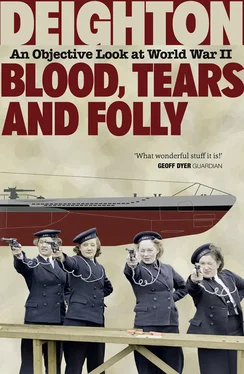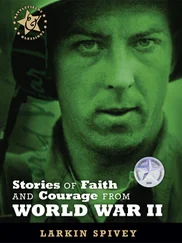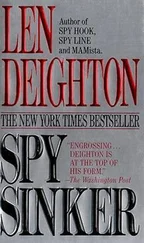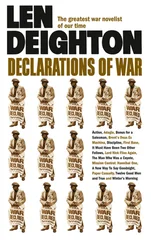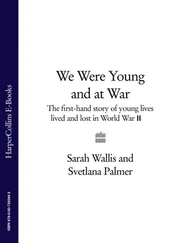The contribution to the war made by women was not limited to Britain. In America Jacqueline Cochrane’s famous Women’s Airforce Service Pilots ferried military aircraft, while flight nurses – the unsung heroines of the US Army – provided critical medical attention to wounded soldiers, saving lives on both the European and Pacific fighting fronts. In Russia, too, all the Red Army’s nurses were women. Those serving as front-line medics were also armed and expected to fight alongside their male comrades when not attending to the wounded. Their casualty rate was approximately equal to that of the Red Army infantry. These women demonstrated that they were every bit as willing to help win a war against an enemy that threatened the life they knew. Together they blazed a trail for equality and their lasting contribution to today’s society deserves to be recognized.
Blood , Tears and Folly is a history of the Second World War concentrating on the early years when Britain and her dominions came near to defeat. The German navy’s use of advanced diesel-electric submarines and the four-rotor Enigma machine almost succeeded in starving Britain of raw materials and food. The Type VII is the iconic U-boat of the Battle of the Atlantic. During the early part of the war they were painted in a resplendent three-colour scheme, including a bright red hull below the waterline (they were later painted solid grey to make them less visible). Built by Krupp Germaniawerft in Kiel and launched in 1938, U-47 , a Type VIIB commanded by Günther Prien that sank thirty ships including the battleship HMS Royal Oak , begins as a line-drawn plan on the back cover before appearing menacingly in full colour on the front. The front-cover photograph of a group of Wrens qualifying at the pistol range exemplifies Britain’s plucky resolve in the face of extreme adversity. This defiant attitude played an important role in convincing a sceptical United States to support Britain in its war against Germany.
Antoni Deighton, 2013
PLATES
1 Before Munich – Winston Churchill talks earnestly in Whitehall to Lord Halifax, Secretary of State for Foreign Affairs, after returning from the Continent in March 1938
2 General Wilhelm Keitel, Hitler’s Army Chief of Staff, in conversation with the Führer on a flight to Munich in March 1938
3 Hitler receives Prime Minister Chamberlain at Obersalzberg in September 1938 – the prime move in ‘appeasement’
4 Admirals Erich Raeder and Karl Dönitz planning the German U-boat campaign in the North Atlantic, October 1939
5 Six days after becoming prime minister, Churchill flew to France for talks on the imminent collapse with General Gamelin and General Lord Gort, commander of the British Expeditionary Force, May 1940
6 General Erwin Rommel, after sweeping through France in May 1940, became the notorious ‘Desert Fox’ of North Africa
7 Hitler meets the fascist Spanish dictator General Franco, October 1940
8 General Thomas Blamey, commander of Australian forces in the Middle East, talks to troops just returned from Crete to Palestine
9 General ‘Dick’ O’Connor with the Commander-in-Chief of British forces in the Middle East, General Sir Archibald Wavell, outside Bardia, Libya, January 1941
10 General Sir John Dill, Chief of the Imperial General Staff, with the Foreign Secretary Anthony Eden in Cairo, March 1941
11 Prime Minister Churchill inspecting part of Britain’s defences in 1940 with a Tommy gun under his arm
12 Hitler discussing progress of the war with the Italian fascist dictator Benito Mussolini, August 1941
13 The German Luftwaffe chief, Field Marshal Hermann Göring, with his deputy Field Marshal Erhard Milch, March 1942
14 Joseph Stalin, the Soviet communist dictator
15 General Douglas MacArthur, Commander-in-Chief of all US forces in the Far East, with President Roosevelt
16 General Arthur Percival, commander of Allied troops in Malaya – a clever and experienced leader who was utterly vanquished by a ferocious Japanese force employing 6,000 bicycles
17 Stalin’s trusted General Georgi Zhukov began his career in the Tsar’s dragoons and defeated first the Japanese and then the Germans
18, 19 General Tomoyuki Yamashita, the ‘Tiger of Malaya’, who was forbidden to return to Japan, and Admiral Isoruku Yamamoto, once a student of Harvard University, who master-minded the attack on Pearl Harbor
20 General Hideki Tojo, first Japan’s war minister and then prime minister
FIGURES
1 HMS Dreadnought
2 German U-boat submarine, type V11C
3 HMS Ajax
4 HMS Exeter
5 German Enigma coding machine
6 British shipping losses in the first year of the war
7 Focke-wulf Fw 200C Condor
8 Short Sunderland flying boat
9 Consolidated Catalina flying boat
10 The German battleship Bismarck
11 The US long-range Liberator, used for convoy escort
12 Comparative ship sizes
13 British Lee-Enfield rifle Mk 111
14 Mercedes and Auto-Union racing cars
15 British Bren light machine-gun
16 British, French and German tanks in use at the start of the war
17 Junkers Ju 52/3m transport aircraft
18 German DFS 230 4.1 glider
19 Heinkel He 111 bomber
20 German Mauser Gewehr 98
21 German MG 34 machine-gun
22 Fairey Swordfish from HMS Illustrious
23 German 8.8mm anti-aircraft/anti-tank gun
24 Heinkel He 280 – the world’s first jet fighter, for which neither Milch nor Udet saw any need
25 British Avro Lancaster bomber
26 Junkers Ju 87 Stuka dive-bomber
27 Supermarine Spitfire and Messerschmitt Bf 109
28 Hawker Hurricane fighter
29 Messerschmitt Bf 110 long-range fighter
30 Dornier Do 17 bomber
31 Junkers Ju 88 bomber
32 The rocket-powered Messerschmitt Me 163 Komet – the fastest aircraft used in the war
33 Germany’s jet-propelled Me 262 – the only jet aircraft to have a significant role in the war
34 Arado 234 ‘Blitz’ bomber (jet)
35 Heinkel 162 ‘Volksjäger’ (jet)
36 Russian Ilyushin 2 Shturmovik
37 Russian T-34 tank
38 Russian machine-pistol PPSh 41
39 Two of the best aircraft of the war the Mitsubishi ‘Claude’ and ‘Zero’ fighters
40 The Japanese aircraft carriers Akagi and Kaga
41 Japanese infantry cyclist
MAPS
1 The pursuit and sinking of the Bismarck
2 North Atlantic convoy escort zones
3 The Maginot Line
4 The invasion of Norway 1940
5 The Westward German armoured offensive
6 German Blitzkrieg and the evacuation of Dunkirk
7 Italy enters the war, June 1940
8 Advance of the Allied XIII Corps along the North African coast, January/February 1941
9 The Mediterranean Theatre 1939–40
10 Battle of Britain – the air battlefield
11 Russian/Japanese battles of 1938–40
12 The expansion of the USSR, 1939–40
13 The ‘buffer states’ between Germany and Russia eliminated by invasions and treaties
14 Russian rail communications
15 Barbarossa: the German Army on the eve of the invasion of the USSR
16 Barbarossa: the first impact
17 German advance towards Moscow, June to December 1941
18 The economic resources of the USSR
19 The German assault on Moscow
20 Petroleum supplies to Britain and Germany 1939
21 World Oil Supplies 1939–45
22 The Japanese assault on Pearl Harbor
23 Japanese invasion routes, and the sinking of Force Z
TABLES
1 Allied shipping losses May–December 1941
2 Relative strengths of the Great Powers in 1939
3 German and Allied casualties, 1940
Читать дальше
